Abstract
Objective
To compare the accuracy of ultrasound (US)-guided and non-US-guided botulinum toxin (BTX) injection into the salivary glands (parotid and submandibular glands) of cadavers.
Methods
Two rehabilitation physician injected dye into three sites in the salivary glands (two sites in the parotid gland and one site in the submandibular gland) on one side of each cadaver (one was injected on the right side, while the other was injected on the left side), using either a non-US-guided injection procedure based on superficial landmarks or a US-guided procedure. Orange dye was used for the US-guided procedure, and green dye was used for the blind procedure. Two physicians uninvolved with the injection procedures and who were blinded to the method of injection dissected the cadavers to identify whether the dye was accurately injected into each target site.
Results
The accuracies of the blind and US-guided injections into the parotid gland were 79.17% and 95.83%, respectively. In the submandibular gland, the accuracies of the blind and US-guided injections were 50.00% and 91.67%, respectively. The difference in accuracy between the two procedures was statistically significant only in the submandibular gland (p=0.025). There were no significant differences in the accuracy of US-guided and non-US-guided injections between the two physicians for the two sites in the parotid gland (p=0.278 and p=0.146, respectively).
Drooling, also known as sialorrhea, is the uncontrolled leakage of saliva outside of the mouth due to a difficulty in swallowing. Drooling is natural in normally-developing infants from 15 to 36 months of age but generally stops by about 18 months. However, it is regarded to be abnormal if it lasts beyond the age of 4 years [1]. Pathologic drooling is related to hypersalivation or to several neurologic disorders such as Parkinson disease, cerebral palsy, amyotrophic lateral sclerosis, stroke, and traumatic brain injury. Anterior drooling—unintentional flow of saliva from the mouth—can lead to clinical and functional problems for patients or caregivers. In the case of posterior drooling, which refers to saliva that is spilled over the tongue through the isthmus of the fauces, aspirationrelated respiratory and pulmonary complications, which have significant effects on mortality and patient prognosis, can occur [2]. Thus, the management of drooling can be an important challenge for rehabilitation physicians. To date, many different treatment options have been proposed for the management of drooling. These have included postural control, radiation therapy, medications such as anticholinergics, or invasive surgical approaches such as duct ligation or gland excision [3]. However, these treatment options are often unsatisfactory, including side effects such as systemic anticholinergic effects, local damage, and increased risk of malignancy with irradiation [4].
The injection of botulinum toxin (BTX) into the submandibular and parotid glands was proposed in 1997 [5]. Since then, multiple studies have evaluated the efficacy of BTX for the treatment of drooling, especially in neurological diseases. Pharmacologically, BTX blocks the release of acetylcholine at the neurosecretory cholinergic synapses of the salivary glands, thereby decreasing salivary secretion. Generally, in the treatment of drooling with BTX injection, the parotid gland is commonly injected into one to three sites and the submandibular gland is usually injected into one site. In previous studies, BTX injection procedures were performed blind using anatomical landmarks or ultrasound (US) guidance [3]. The risks of the procedure include induced weakness of the adjacent muscles, leading to a difficulty in swallowing due to an incorrect injection of the toxin into the masseter or pharyngeal muscles [6]. Other potential risks include hematoma and injury to the carotid arteries or the facial nerve. Although recent investigations have reported the increased efficacy and safety of BTX injection under US guidance [7], there have not been any studies comparing the injection accuracy between blind and US-guided approaches. This study was designed to evaluate the injection accuracy of blind and US-guided botulinum injections into the parotid and submandibular glands of fresh cadavers.
Six fresh frozen cadavers were used. Four glands (2 parotid glands and 2 submandibular glands) of each cadaver were injected; two injections in each parotid gland and one injection in each of the submandibular glands resulting in a total of 6 site injections per cadaver. No significant deformities of the head and neck due to pre-mortality trauma or surgery were found in the six cadavers.
Two rehabilitation physicians injected dye into 3 salivary gland sites (two sites in the parotid gland, and one site in the submandibular gland). Each physician injected dye into one side of each cadaver (one physician injected BTX into the right side of the cadaver, while the other injected BTX into the left side), since repeated injections around the same place may obscure the precise location of the dyes within the glands. Physicians injected dye twice into each site using either a non-US-guided technique (based on superficial landmarks) or a US-guided technique. Two rehabilitation physicians participated in this study. The one was a rehabilitation physician and an experienced sonographer with over 5 years of experience. The other was a rehabilitation physician who had 3 years of clinical ultrasound experience with. Physicians injected different colored dyes into the target sites of the glands for each procedure—green dye was used for the blind injections and orange dye was used for the US-guided injections. The dye was a blended solution of oil-based paint and acrylic gel, added to increase the viscosity of the dye. About 0.5 mL of this mixed solution was injected into each site using a 25-gauge 1.5-inch needle.
The injections were carried out using a 1 ml syringe with a 25-gauge 1.5-inch needle piercing each site to a depth of 1–1.5 cm. One parotid gland site was behind the ascending mandibular ramus; while, the other site was the infero-posterior portion of the gland, just before the mastoid process [8] (Fig. 1A).
The instruments used for injections were the same as those described above. Based on a reference line connecting the mandibular angle and the gnathion, the insertion site was located 20%–35% from the mandibular angle and 1.5 cm below the line of the inferior mandible. The depth of needle insertion was 2.0 cm below the skin [9] (Fig. 1B).
High-resolution ultrasonography was used to identify the salivary glands and nearby structures. US guidance was performed using a 45-MHz linear transducer (RS80A; Samsung Medison, Seoul, Korea). Under ultrasound guidance, injections were performed via a lateral approach by positioning the head facing away from the side to be injected. Searching for the precise location of gland, the needle was inserted perpendicularly to the ultrasound transducer in-plane. Then, under US guidance, the dye was injected following verification of the needle position and dye deposition was dynamically visualized (Fig. 2).
Two physicians who were uninvolved with the injection procedure and who were blinded to the method of injection dissected the cadavers in order to determine whether the dye was correctly injected into each target site (Fig. 3). The injection procedure was regarded to be ‘accurate’ when the dye was visualized as being located in the intraglandular area and as ‘inaccurate’ when it was not seen in the intraglandular area (Fig. 4).
Data analysis was performed using SPSS ver. 21 for Windows (IBM, Armonk, NY, USA). We used the chi-square test both to analyze differences in the accuracy rate between non-US-guided and US-guided injection and to analyze differences in accuracy rates between the two physicians. The p-values of less than 0.05 were considered as being significant.
The accuracy rates of the blind versus the US-guided injections into the parotid glands were 79.17% and 95.83%, respectively. The difference between the two procedures was not statistically significant (p=0.081). In the submandibular gland, the accuracy of the blind and US-guided injections was 50.00% and 91.67%, respectively. The difference between the two procedures, in this case, was significant (p=0.025). The overall accuracy of non-US-guided and US-guided injection was 69.4% and 94.4%, respectively (p=0.006) (Table 1). Incorrect injections were defined as those into the adjacent masseter muscle or the subcutaneous fat tissue for the parotid gland injection and those into the mylohyoid muscle or subcutaneous fat tissue for the submandibular gland injection (Table 2).
The injection of BTX into the salivary glands for the management of drooling is widely used in patients with certain neurologic disorders. A number of previous reports have demonstrated its efficacy and safety and the procedure is now frequently used by many physicians. In the past, clinicians have usually injected BTX into both the parotid and submandibular glands using a ‘blind’ procedure [4]; however, US-guided procedures have recently become popular.
The use of US in the medical field has been increasing due to the numerous advantages of doing so. US enables dynamic, real-time monitoring during needle injection, and it is fast, less invasive, and has no associated risk of radiation exposure. However, the ‘blind’ injection method is still used by many clinicians because of its convenience. Yet, inappropriate BTX injection can damage important structures around the salivary glands, such as muscles, arteries, and nerves. Inappropriate BTX injection can also cause weakness in the adjacent muscles, resulting in swallowing or mastication difficulties. Furthermore, injury to structures such as a carotid artery or the facial nerve can be fatal to patients [10]. In addition, the accuracy of the BTX injection is an important factor that determines the efficacy of the procedure. Considering the pharmacologic mechanism of BTX, inaccurate injection into the periglandular structures will reduce the effect of the toxin at the target site [11]. Thus, increased accuracy of injections can lead to better clinical outcomes.
Considering these factors, our study compared the accuracy of blind and US-guided injection of the salivary glands. We examined the accuracy of non-US-guided versus US-guided dye injection, in two sites in the parotid glands and one site in the submandibular gland, in 12 specimens. In the parotid gland, the differences in accuracy between the two procedures was not found to be significant. Previous studies comparing non-US-guided injection and US-guided injection have reported mixed results. Some studies have reported that US-guided parotid injection improves efficacy and safety as compared to non-US-guided injection procedures [7]. However, another study reported no significant difference in parotid gland BTX injection efficacy between non-US-guided injection and US-guided injection [12]. Since the parotid gland is large, wide, and superficially located, its injection in blind procedures is thought to be relatively accurate. However, in the submandibular gland, the difference in accuracy between the two procedures was found to be statistically significant. Although the anatomical localization of the submandibular gland for BTX injection study has been reported in previous studies, a comparison of the accuracy of injection into the submandibular gland using US-guided as compared to non-guided techniques has not been reported. The submandibular gland is the major gland responsible for resting saliva secretion; while the parotid gland is predominantly active during mastication [6]. Patients with neurological disorders often suffer from drooling while in the resting state rather than during eating. Thus, control of the saliva secreted by the submandibular gland is more important than control of the saliva from the parotid gland [13]. Since the submandibular gland is smaller than the parotid gland and can present in varying positions [13], injection into the target area can be difficult. In addition, adjacent structures around the submandibular gland, such as fat tissue and complex musculature, make it difficult to palpate the gland itself; thus, making it difficult to accurately inject BTX into the gland.
In the present study, injections were incorrectly placed in various sites. In the parotid gland injections, the erroneous locations were the masseter muscles and subcutaneous fat tissue. In the submandibular gland injections, the erroneous locations were the mylohyoid muscles and subcutaneous fat tissue. The injection of toxin into the masseter muscle can cause mastication issues. More importantly, toxin injection into the mylohyoid muscle can cause severe dysphagia associated with aspiration that can be fatal to patients with neurologic disorders [9]. In addition, although we could not find evidence of penetrated neurovascular structures, dye was found just beside the facial artery in some blind injection cases. We could not reach a conclusion as to the safety of US-guided injection with regards to vasculature because there is no dynamic blood flow in cadavers. However, it is undeniable that US-guided injection in live patients decreases the risk of neurovascular puncture. Given the risk of intramuscular injection and neurovascular puncture, our position is that US guidance should be considered when managing drooling with BTX injection into the submandibular gland.
Our study has several limitations. Firstly, the sample size was small because we were limited to six fresh cadavers. Furthermore, each physician performed glandular injections in only one side of each cadaver, as repeated injections may obscure the precise location of the dyes within the glands. In the case of the parotid gland, the difference in the accuracy of injection is not as great as in the submandibular gland and was not statistically significant; however, this result might be due to the small sample size. Secondly, accuracy differed somewhat from the comparisons of efficacy that had previously been reported. Although BTX was injected into the subcutaneous tissue, its diffusion might affect the comparison of efficacy with regards to the outcome of drooling. However, comparing the rates of accuracy may be more valuable than comparing their efficacy, when considering the safety and maximal effects of BTX injection [13].
In conclusion, the present study provides evidence that US-guided BTX injection into the submandibular gland offers significantly greater accuracy over blind injection. The use of ultrasound has many advantages, including convenience and the absence of risk of radiation exposure. Therefore, when treating drooling by injecting BTX into the submandibular gland, clinicians should consider using US guidance in order to improve accuracy. Moreover, for improved safety, we think that US-guided injection into the parotid gland may also be considered.
ACKNOWLEDGMENTS
The authors would like to thank the Department of Anatomy at Seoul St. Mary's Hospital, College of Medicine, the Catholic University of Korea, Seoul, Korea, for its cooperation.
References
1. Garnock-Jones KP. Glycopyrrolate oral solution: for chronic, severe drooling in pediatric patients with neurologic conditions. Paediatr Drugs. 2012; 14:263–269. PMID: 22646067.
2. Jongerius PH, van Hulst K, van den Hoogen FJ, Rotteveel JJ. The treatment of posterior drooling by botulinum toxin in a child with cerebral palsy. J Pediatr Gastroenterol Nutr. 2005; 41:351–353. PMID: 16131993.

3. Lakraj AA, Moghimi N, Jabbari B. Sialorrhea: anatomy, pathophysiology and treatment with emphasis on the role of botulinum toxins. Toxins (Basel). 2013; 5:1010–1031. PMID: 23698357.

4. Meningaud JP, Pitak-Arnnop P, Chikhani L, Bertrand JC. Drooling of saliva: a review of the etiology and management options. Oral Surg Oral Med Oral Pathol Oral Radiol Endod. 2006; 101:48–57. PMID: 16360607.

5. Bushara KO. Sialorrhea in amyotrophic lateral sclerosis: a hypothesis of a new treatment: botulinum toxin A injections of the parotid glands. Med Hypotheses. 1997; 48:337–339. PMID: 9160288.
6. Sriskandan N, Moody A, Howlett DC. Ultrasound-guided submandibular gland injection of botulinum toxin for hypersalivation in cerebral palsy. Br J Oral Maxillofac Surg. 2010; 48:58–60. PMID: 19371986.

7. Dogu O, Apaydin D, Sevim S, Talas DU, Aral M. Ultrasound-guided versus ‘blind’ intraparotid injections of botulinum toxin-A for the treatment of sialorrhoea in patients with Parkinson's disease. Clin Neurol Neurosurg. 2004; 106:93–96. PMID: 15003297.

8. Lagalla G, Millevolte M, Capecci M, Provinciali L, Ceravolo MG. Long-lasting benefits of botulinum toxin type B in Parkinson's disease-related drooling. J Neurol. 2009; 256:563–567. PMID: 19401804.

9. Lee JH, Lee BN, Kwon SO, Chung RH, Han SH. Anatomical localization of submandibular gland for botulinum toxin injection. Surg Radiol Anat. 2010; 32:945–949. PMID: 20221760.

10. Scully C, Limeres J, Gleeson M, Tomas I, Diz P. Drooling. J Oral Pathol Med. 2009; 38:321–327. PMID: 19236564.

11. Jongerius PH, Joosten F, Hoogen FJ, Gabreels FJ, Rotteveel JJ. The treatment of drooling by ultrasound-guided intraglandular injections of botulinum toxin type A into the salivary glands. Laryngoscope. 2003; 113:107–111. PMID: 12514392.

12. Svetel M, Vasic M, Dragasevic N, Pekmezovic T, Petrovic I, Kostic V. Botulinum toxin in the treatment of sialorrhea. Vojnosanit Pregl. 2009; 66:9–12. PMID: 19195257.

13. Lim M, Mace A, Nouraei SA, Sandhu G. Botulinum toxin in the management of sialorrhoea: a systematic review. Clin Otolaryngol. 2006; 31:267–272. PMID: 16911641.

Fig. 1
Locations of the non-ultrasound-guided parotid gland injections (A) and submandibular gland injections (B). Injection points were marked with blue dots and squares, respectively. M, mandible; MP, mastoid process; MAS, masseter muscle; SCM, sternocleidomastoid muscle; G, gnathion; DM, digastric muscle; MA, mandibular angle.
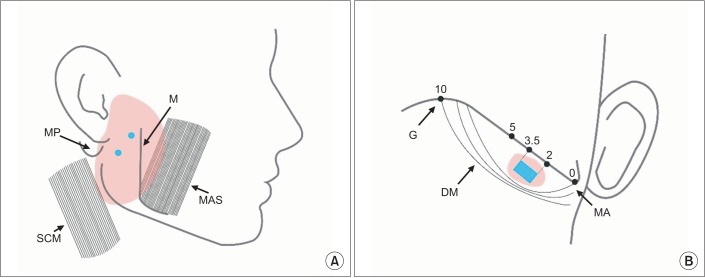
Fig. 2
Ultrasound-guided dye injection into the salivary gland: (A) parotid gland (PG) and (B) submandibular gland (SMG). Intraglandular injectate (arrow head) and needle placement (arrow) are shown in this figure.
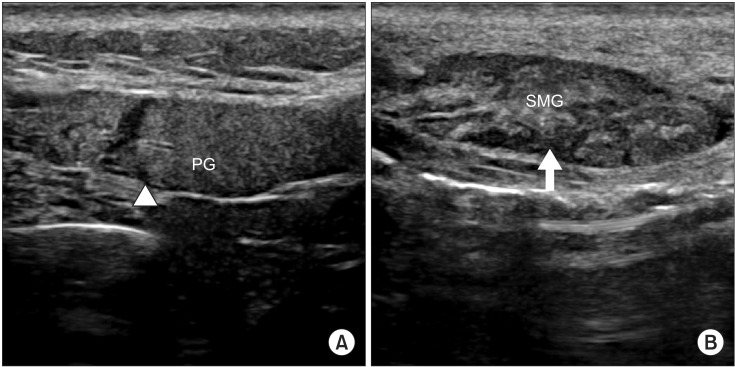
Fig. 3
Dissected cadaver with non-ultrasound-guided injection (green dye, arrow head) and ultrasound-guided injection (orange, arrow): (A) parotid gland (PG) and (B) submandibular gland (SMG). Non-ultrasound-guided injection that was incorrectly placed into the subcutaneous fat tissue (B).
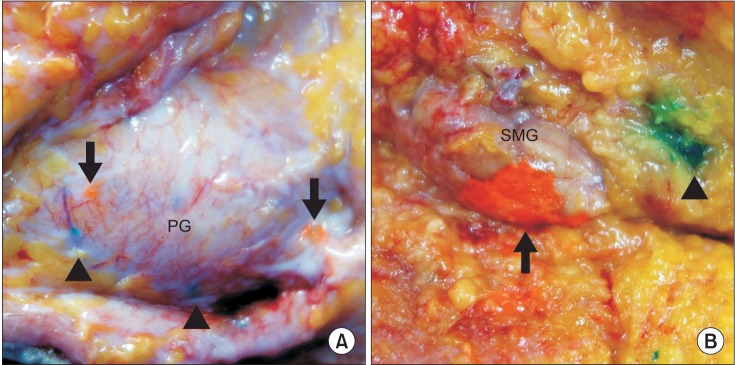
Fig. 4
Extracted submandibular gland. We determined whether the dye was located in the intraglandular area by incising the gland.
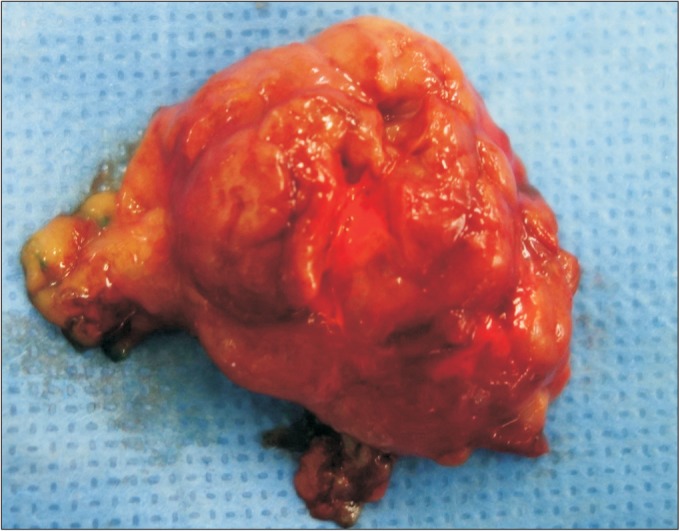




 PDF
PDF ePub
ePub Citation
Citation Print
Print



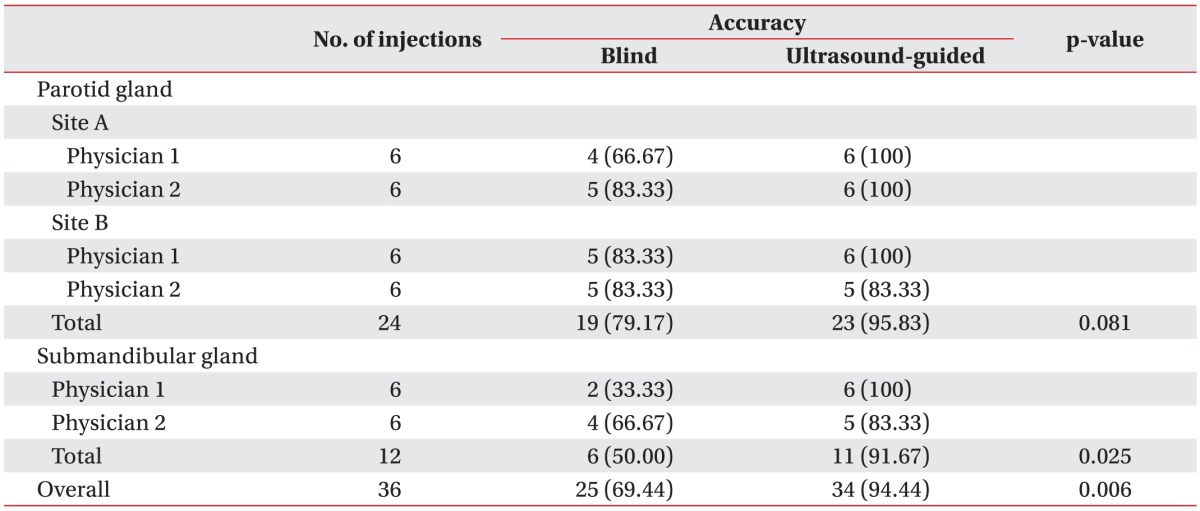

 XML Download
XML Download